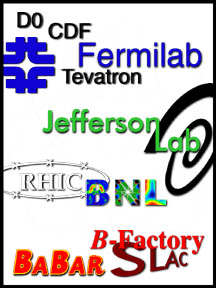
Printable version of all pages (color PDF)
The content contained on this page and the pages linked to it were prepared in January 1999 for the Strategic Simulation Initiative. Printable versions (color PDF and postscript) are also available.
|
|
![]()
Printable version of this page (color PDF or postscript)

The field of High Energy and Nuclear Physics (HENP) will soon be acquiring more
experimental data, and with it more chances to observe new phenomena and make new
discoveries. DOE projects nearing completion are the
BaBar detector at
the SLAC B-Factory, new experiments at Brookhaven
Relativistic Heavy-Ion Collider (RHIC), upgraded experiments at the Fermilab Tevetron, and at Jefferson
Lab. These experiments, as well as U.S. participation in the Large Hadron Collider at CERN in Geneva, have the opportunity to increase
knowledge of the physical world in unprecedented ways, through unprecedented amounts of
data. The volume of data, however, absolutely demands new computer science tools for data
management at scales previously unheard of. The Strategic
Simulation Initiative (SSI) will provide the cross cutting computational
infrastructure to propel science to new levels and scientists in HENP can help given their
background in data management.
But answers to fundamental questions about the nature of the universe will not simply leap out from these laboratories. They will be subtly hidden in the raw data. Large-scale numerical simulations of theoretical models are needed to compare data with theory, test the Standard Model and exciting new physics beyond it. These simulations will require computing power of the scale envisioned for SSI to allow theorists to discover new possibilities.
Beyond the upcoming generation of experiments, other future facilities will be needed. SSI offers dramatically new levels of performance and capability for accelerator modeling to design compact, high-energy accelerators of the future, involving 3D geometry and large beam-generated fields, for example. Components could be designed with significantly improved performance and cost effectiveness, and accelerator simulations might eventually approach the level of a complete accelerator system. HNEP has a long history of designing and building their own supercomputer systems to support their studies, so physicists can make valuable contributions.
Collaborations increasingly involve geographically-distributed colleagues. Current and planned network capabilities will free researchers from the need to be physically located near their data or computers. Hardware and software tools to facilitate effective collaborations at a distance and the network capability to sustain them are crucial for sustaining synergy among highly motivated researchers.
At the end of the 19th century, J. J. Thompson measured the electron and developed his "plum-pudding" model of the atom. At the end of the 20th century, we have the Standard Model but some tantalizing questions. With SSI computational science ability, high energy and nuclear physicists can make unprecedented advances in the next century.